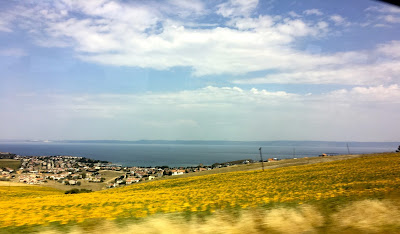Mum booked a two day tour because she knew how much I wanted to go to Gallipoli, it was the reason we came to Istanbul on the way to Jordan (also because it was cheaper!). We left early this morning in our own van for the Gallipoli peninsular, no one else had booked the tour because apparently there aren't many Australians visiting Turkey, and it's mostly Australians, New Zealanders and British who want to go there.
The van had wifi! So Mum listened to podcasts about the Gallipoli campaign but I preferred to spend the 4 hours looking out the window absorbing what I saw.
You can see on the map Istanbul and the place we stopped for lunch on the peninsular. It took us longer than 2hrs 52 mins because we stopped on the way.
I've read about the Dardanelles and why they were important to the Allies, so I was excited to get my first glimpse of them. The van was moving fast here are some photos of the Gallipoli peninsular. Gallipoli is an Italian word from a Greek word which means beautiful city. The Greeks were here in 60BCE, then the Romans. The Peleponsian war relics have been found here. Archeologists have been exploring the peninsular for years because everyone wanted control of the Dardenelles because of its strategic location to the Black Sea. Attila the Hun was here, and it was the Ottoman's first part of Europe they captured in the 1400s, after the 1354 earthquake.
It was known for its wheat, but we saw sunflowers.
And of course, it was where the first campaign Australians fought in during WW1, but I'll write a lot more about that later.
This was my first glimpse of the Dardanelles.
We finally stopped at a small cafe on the edge of the Dardanelles for lunch. It was water the ANZACS never saw because they didn't penetrate the peninsula.
 After lunch we went on a boat to sail around the other side to the Aegean Sea. We boated past the ANZAC landings, ANZAC cove, North Beach and up to Suvla Bay where the British landed in August. We didn't go to Helles where the British landed the same day the ANZACS did at ANZAC cove. The tour was meant to do the battlefields on the first day but because the weather was forecast to rain tomorrow they decided to go on the boat first. This actually was a good thing beause I was able to see the coastline and the rugged, steep rocky hills that confronted the ANZACS. It gave me a good perspective.
After lunch we went on a boat to sail around the other side to the Aegean Sea. We boated past the ANZAC landings, ANZAC cove, North Beach and up to Suvla Bay where the British landed in August. We didn't go to Helles where the British landed the same day the ANZACS did at ANZAC cove. The tour was meant to do the battlefields on the first day but because the weather was forecast to rain tomorrow they decided to go on the boat first. This actually was a good thing beause I was able to see the coastline and the rugged, steep rocky hills that confronted the ANZACS. It gave me a good perspective.
Here are some photos of the peninsular. You can see how narrow the beaches are and how steep the cliffs are - where the Turks were waiting.
Oh, and we then stopped to swim and snorkel off North Beach. I snorkled over the sunken SS Milo. In October 1915 the SS Milo was grounded, so it was filled with cement and used as a jetty to protect North Beach from bad weather. She was also used as a generator for electric light when the ANZACS were there.
In 1810 Lord Byron swam across the Dardanelles. I didn't follow!
It actually wasn't very warm in the water, it was only about 26 degrees out of the water, so tea was welcome after I'd been in the water for about an hour. Mum was only in for about 15 minutes!

Straight after the boat trip we caught a car ferry to Cannakale for the night. There was a huge storm and no photos because we were drenched. The storm passed and this is the view from our hotel. We went for a walk but could only find bars, so we went back to the hotel to sleep. This was the exact time the suicide bombers were attacking the international airport in Istanbul, but we didn't find out about it till Facebook, Instagram and Snapchat messages were pinging at us during the night. (more later)


















No comments:
Post a Comment